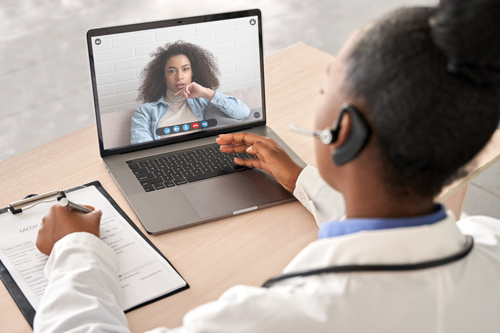Enter your email to receive the CareQuest newsletter:
December 10, 2021
For Dr. Mina Paul and Dr. Brianna Hillier, teledentistry has been an invaluable addition to their daily work.
“Teledentistry is here to stay, and I am absolutely an advocate,” said Paul. “There’s a lot more we can do.”
In the past two years, the COVID-19 pandemic required many providers like Dr. Paul and Dr. Hillier to rethink how to treat patients outside of a traditional office setting safely and effectively. Teledentistry — using telehealth systems and methodologies within oral care — quickly gained momentum.
The emergence of teledentistry led to learning curves and challenges during the pandemic while spotlighting the power of providing equitable access to oral health care. Whether it was within a dental office, in a community setting, or, often during the pandemic, from a patient’s home, the array of virtual tools allowed for convenient and urgent care.
“Providers can assess patients’ needs and comfort level, and then manipulate schedules so the patient can get an appropriate appointment time,” Dr. Paul said.
A Quick Pivot in March 2020
As the dental director for East Boston Neighborhood Health Center’s various dental clinics in usetts, Dr. Paul first launched a teledentistry program in March 2020 to provide urgent care at the beginning of the pandemic.
“Teledentistry was a learning moment in terms of doing nonvisual work,” Dr. Paul explained. “My skill set expanded during virtual exams and fortified the patient bonding experience. I found I could spend more time with patients than I normally would pre-pandemic. Patients felt like someone was really listening and taking time to ask more questions.”
Dr. Hillier, the director of dental services, Chiricahua Community Health Centers, Inc., in Cochise County, Arizona, was also quick to see the benefits of a virtual connection.
“I can take good intra-oral photos and radiographs virtually during teledentistry appointments,” she said. “The  patient doesn’t need to physically come in, and they are very thankful for that. For rural communities like the one I work in, teledentistry is an asset at this point. It’s a barrier to care if you can’t do it.”
patient doesn’t need to physically come in, and they are very thankful for that. For rural communities like the one I work in, teledentistry is an asset at this point. It’s a barrier to care if you can’t do it.”
As the pandemic has continued, the value of teledentistry has remained.“We [still] have telehealth calls every day,” Dr. Paul said. “It’s very common to get three or four call requests a day and for my providers to make those calls to triage patients. What we’re doing is a win-win in the sense that people can get the care they need a lot faster by phone.”
Triaging patients, in particular, was a huge benefit in emergency situations. Dr. Paul also points out how teledentistry is beneficial not just in terms of administrative work but also in providing patients immediate treatment.
“The other piece to teledentistry is sometimes patients will have emergencies your health center is not equipped to handle, and they don’t know where to go,” Dr. Paul added. “This makes teledentistry advantageous in triaging and directing patients to the right place sooner than later.”
Connecting Through COrHT
Dr. Paul and Dr. Hillier both participated in CareQuest Institute for Oral Health’s Community Oral Health Transformation Initiative, gaining more knowledge and insights about teledentistry.
The COrHT initiative, which began during the pandemic, serves as a learning community for the implementation of medical-dental integration and value-based oral health care.
“We participated in the CoHRT program, and I found some of the tips very useful to help flesh out questions and customize care according to what we need to do to serve our population,” Dr. Paul said. “Every population is different and made up with different demographics. Some of the COrHT presentations helped spark ideas for how to address this in the future.”
Dr. Hillier found the medical-dental integration discussions within COrHT particularly useful.
“I use the COrHT system’s Three Domain Framework to take a step back and learn how I could further help my medical team from within my dental clinic,” she said. “For example, I am now thinking about more integration opportunities so I can go into the nooks and crannies of the rural communities I serve and help.”
The Potential of Teledentistry
That focus on the unique needs of rural communities is top of mind for both Dr. Hiller and Dr. Paul.
“There are patients who can’t come see us as easily,” Dr. Paul explained. “So, a lot of times these community members are not patients of the dental clinic and literally have nowhere to go. That’s where we step in and provide access to care and serve as a beacon for patients to get some sort of solace and treatment. Teledentistry helps open avenues and options for patients in need.”
The advantages of teledentistry — improving access in rural settings, person-centered care, ability to triage — point to its staying power.
“I’ve talked to colleagues across the country, and they are looking at different ways of handling follow-up and consult appointments and oral hygiene,” Dr. Paul said. “As a community health center that’s not where we’re currently at with teledentistry, but five years down the line with the support of infrastructure, insurance companies, and guidelines, we can go a lot further.”